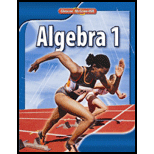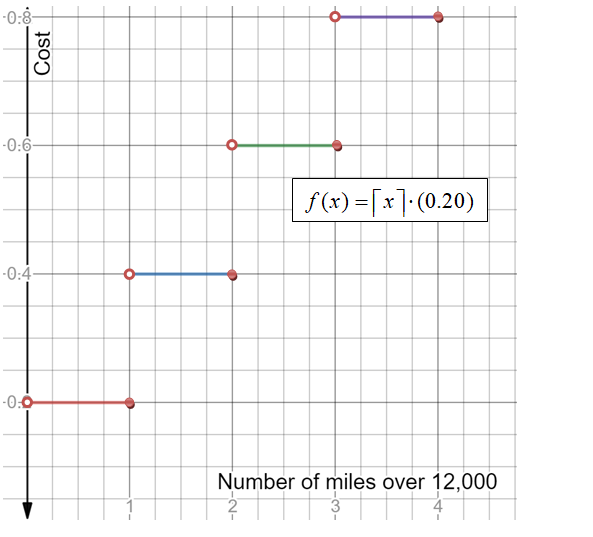
Concept explainers
To Graph:
Draw a graph to represent the cost of going over the mileage.
Explanation of Solution
Given Information:
As per Marcus’ leasing agreement , he will be charged $0.20 per mile for each mile over 12,000.Any fraction of a mile is rounded up to the next mile.
Concept Used:
Least Integer Function:
The function whose value at any number x is the smallest integer greater than of equal to x is called the least integer function.
It is denoted by
For example
Calculation:
Charges per mile above 12,000 miles = $0.20
For any fraction of a mile above 12,000 miles , we round it up to the next mile and then take the following steps ( for example , for 0.6 miles , we take number of miles , x = 1) :
So , for x miles above 12,000 miles , we take ceiling of x =
So, for x miles above 12,000 miles, we have the charges will be applied =
Cost of going x miles above 12,000 miles =
We make a table for different number of miles above 12,000 miles and Cost of going above the mileage:
| Number of miles over 12,000 (x) | Rounded up value = | |
| 1 | 1 | 0.20 |
| 1.5 | 2 | 0.40 |
| 2 | 2 | 0.40 |
| 2.5 | 3 | 0.60 |
| 3 | 3 | 0.60 |
| 3.5 | 4 | 0.80 |
| 4 | 4 | 0.80 |
Graph:
From the table above , we draw the graph of the function :
Where to use the dots and circles :
At 12,000 miles, the cost is included in rental, so it is a circle at (0,0.20).
From 12,000 miles (excluded ) to 12,001 miles (included) , there is a cost of $0.20.
So, at x = 1( that is at 12,001 miles) , the cost is $0.20.
So, at (0,0.20) , there is a circle and at (1,0.20) , there is dot.
From 12,001 ( x =1) to 12,002 ( x = 2 ) miles , the cost is $0.40 , but 12,001 not included and 12,002 is included.
So, at (1,0.40) , there is a circle and at (2,0.40) , there is dot.
Plot the points and join.Continue the proess.

Chapter 4 Solutions
Algebra 1
Additional Math Textbook Solutions
Calculus: Early Transcendentals (2nd Edition)
Calculus: Early Transcendentals (2nd Edition)
A First Course in Probability (10th Edition)
University Calculus: Early Transcendentals (4th Edition)
Introductory Statistics
Elementary Statistics: Picturing the World (7th Edition)
- Solve the following system of equations: 50x+20y=1800 10x+3y=300arrow_forward> > > we are hiring Salesforce Admin Location: Remote Key Responsibilities: Administer Salesforce Sales & Revenue Cloud (CPQ & Billing) Configure workflows, validation rules & dashboards Automate processes using Flows & Process Builder Collaborate with Sales, Finance & Marketing teams Manage user roles & security Apply: Hr@forcecraver.comarrow_forwardAnswer this questionarrow_forward
- 1. vector projection. Assume, ER1001 and you know the following: ||||=4, 7=-0.5.7. For each of the following, explicitly compute the value. འབ (a) (b) (c) (d) answer. Explicitly compute ||y7||. Explain your answer. Explicitly compute the cosine similarity of and y. Explain your Explicitly compute (x, y). Explain your answer. Find the projection of onto y and the projection of onto .arrow_forward2. Answer the following questions using vectors u and v. --0-0-0 = find the the cosine similarity and the angle between u and v. འརྒྱ (a) (b) find the scalar projection of u onto v. (c) find the projection of u onto v. (d) (e) (f) find the scalar projection of onto u. find the projection of u onto u. find the projection of u onto and the projection of onto . (Hint: find the inner product and verify the orthogonality)arrow_forwardPlease type out answerarrow_forward
- The function f(x) = log x is transformed to produce g(x) = log (x) – 3. Identify the type of transformation and describe the change. Please type out answerarrow_forwardEach graph below is the graph of a system of three linear equations in three unknowns of the form Ax = b. Determine whether each system has a solution and, if it does, the number of free variables. A. O free variables ✓ B. no solution C. no solution D. no solution E. 1 free variable F. 1 free variablearrow_forwardSolve the following systems of equations and show all work.y = x2 + 3y = x + 5 Please type out answerarrow_forward
 Algebra and Trigonometry (6th Edition)AlgebraISBN:9780134463216Author:Robert F. BlitzerPublisher:PEARSON
Algebra and Trigonometry (6th Edition)AlgebraISBN:9780134463216Author:Robert F. BlitzerPublisher:PEARSON Contemporary Abstract AlgebraAlgebraISBN:9781305657960Author:Joseph GallianPublisher:Cengage Learning
Contemporary Abstract AlgebraAlgebraISBN:9781305657960Author:Joseph GallianPublisher:Cengage Learning Linear Algebra: A Modern IntroductionAlgebraISBN:9781285463247Author:David PoolePublisher:Cengage Learning
Linear Algebra: A Modern IntroductionAlgebraISBN:9781285463247Author:David PoolePublisher:Cengage Learning Algebra And Trigonometry (11th Edition)AlgebraISBN:9780135163078Author:Michael SullivanPublisher:PEARSON
Algebra And Trigonometry (11th Edition)AlgebraISBN:9780135163078Author:Michael SullivanPublisher:PEARSON Introduction to Linear Algebra, Fifth EditionAlgebraISBN:9780980232776Author:Gilbert StrangPublisher:Wellesley-Cambridge Press
Introduction to Linear Algebra, Fifth EditionAlgebraISBN:9780980232776Author:Gilbert StrangPublisher:Wellesley-Cambridge Press College Algebra (Collegiate Math)AlgebraISBN:9780077836344Author:Julie Miller, Donna GerkenPublisher:McGraw-Hill Education
College Algebra (Collegiate Math)AlgebraISBN:9780077836344Author:Julie Miller, Donna GerkenPublisher:McGraw-Hill Education





